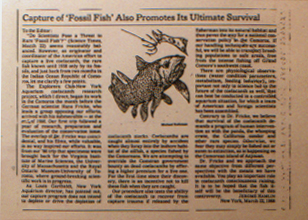Recollections of the Past 30 years pursuing Coelacanths
Jerome Hamlin, creator dinofish.com
Dealing with the very complicated logistics of the project, and having covered all bases including science and conservation, I was now suddenly dealing with politics, and for this I was ill prepared. In a panic, New York Aquarium, thanked me for helping with the project they had initiated, and said they were taking over. Of course, they hadn't initiated the project, so that led to a parting of the ways. Attacks and responses flew back and forth between our side and the submarine group. I had an op ed published in the New York Times, but they added a cartoon showing a coelacanth biting at a dollar bill on a hook. The only things we had going after the melee was the decompression cage Peter and I had sent to Anjouan, and the large insullated transporter tank the aquarium had sent to the Comoros before our fall '87 arrival. The acting director of New York Aquarium said he would still feel morally obligated to assist if we had a fish in the large transporter tank. That was all that was left of two year's work

The New York Times published a letter to the editor I wrote in response to a critical article, but adds a cartoon of a coelacanth about to snap at a dollar. (Through this letter, I later met Francine Storey, who wrote the famous coelacanth poem, "Instructions for Search" on the website.)
So what was really going on here? I had a good idea. When the submarine group arrived in the Comoros, they would have heard of our visit just before them. Competition? At the same time, they would have learned that we and the Japanese group before us offered money for a living fish. They would have seen the dead fish in the freezer rooms and believed they were being targeted. (Their sponsoring organization, the Max Planck Institute even had placed an order for one!)They would also have heard the same rumors we did that one of the French mercenaries then living on the island was offering coelacanths for sale aside from the official government channels, in other words the existence of a black market. They would have heard the rumor that wealthy Japanese were willing to pay millions for the spinal fluid of a coelacanth because they believed it promoted longevity. So their concerns may have seemed both legitimate and self beneficial.
But the "ground truth" I observed in the Comoros was quite different. Coelacanths were being caught as random bycatches and were not responding to targeting by the fishermen. There were plenty of them piling up in the freezer rooms, more than the government could dispose of. The government was very inefficient at paying the reward price to fishermen for bringing them in, so fishermen were not adverse to selling them to non governmental intermediaries for immediate cash: hence the mercenary and the "black market." In some cases, the fishermen in more remote areas, simply ate the coelacanths without bothering to hand them over to anyone else. There was no documented report of a wealthy Japanese ever paying millions for coelacanth notocordal fluid. But these arguments were so similar to the rhino horn scenario that they caught on in a flash, as a shared "meme." Great for funding purposes, the faux narrative of coelacanths near extinction due to outside pressures continued for decades in both scientific and popular writings. The only person of scientific importance to publicly support a counter narrative, in those early days, was John McKosker, director of the Steinhardt aquarium in San Francisco, who had led his own collecting expedition in the 70's.
